#anti max hastings
Explore tagged Tumblr posts
Note
I think we need to start an anti-Max Hastings club or something bc the fics/posts are getting out of hand and i need to know there are still sane people about 😭
Literally so real. If I see one more MaxPip fic (which is extremely likely, because that weirdo who posted the one based on Guilty as Sin said they're posting another part soon), I'm gonna lose it. I just do not understand how hard it is to understand that Max shouldn't be romanticised? He's a fucking freak. But I guess people will go crazy for a shirtless blond guy, even if he's a fucking rapist 🙄
Yes, we need to start an anti Max Hastings club 😭 anyone who's actually read the books + watched the show with their eyes open would join the club because no sane person should like Max Hastings and/or ship him with Pip 😭
#agggtm#a good girl's guide to murder#max hastings#anti max hastings#max hastings drop dead asap#max hastings you're an ugly loser#and anyone who likes Max is a freak#don't like calling others freaks but there's an exception this time#max hastings lovers are freaks
22 notes
·
View notes
Text
Live footage of me at 1 am in the middle of a 40 plus hour PD work week but I must write the blorbos and not be silenced

#im so exhausted and sleep deprived#but im a woman on a mission#my sworn duty#to piss off antis even more akdkf#a good girls guide to murder#agggtm#max hastings#pippa fitz amobi#max x pip#max x pippa#maxpip#otp: down the hatch#dead dove do not eat#dark ship#i feel like tht dw meme but i carry on
5 notes
·
View notes
Text
Haunting
Whumptober Day 10: "Can't you see that you're lost without me?"
No matter where Chase goes, the shadow follows.
He's ditched his car and three others in the last day, driving the gas tanks down to their last dregs in his haste to get away. He doesn't have a destination in mind other than away, yet with each mile down the unforgiving highway, the chill down his spine rankles him even more.
He slaps his hand over the back of his neck, like the sting would make the crawling fade away.
"There aren't any more cameras," he mutters under his breath. "I'm safe now. It's fine."
But how can he be so sure? Ever since those freaky scientists guys were murdered, he's had to hop between towns, losing the trail of whatever people or things want to find him. He hasn't heard from Echo since he escaped IRIS. He has no idea what the public knows about him. (Would IRIS send out a manhunt? Do people think he's a criminal?) He has no sense of where to go or what to do but survive.
Why couldn't this have been a misunderstanding? Why didn't they let him go home?
What does Anti want from him?
The ghost of a breath sends a shiver down his spine, and he cranks the heat in the current old beater to the max. It sputters out a smog of hot diesel from the exhaust; his face screws up at the stench.
He's been in this rustbucket truck for too long. Hopefully the more inland he goes, the easier it'll be to find a rural town to swap cars. The sooner he can find a gas station without CCTV, let alone a WATCHR, the better.
Except the beater doesn't get him that far.
Something rattles under the hood, and a plume of smoke sparks and slithers out through the cracks. Chase curses and slams the steering wheel and pulls over three miles before the next exit, then grabs his meager belongings and sprints away as he hears a resounding boom and a rush of heat scorches his back.
It exploded. The truck fucking exploded.
With his heart in his throat, Chase reaches for his back pocket and nearly falls over in relief. The picture is still there. Even after everything, he hasn't lost it. He can't.
"For someone trying to avoid me, you put on quite the show."
Chase lurches and goes for the gun in his waistband, only to jolt when he comes up empty. It must still be in the center console, melting into a mangled mess with the rest of the scorching hot metal in front of them.
His hands flex and curl into fists. He doesn't want to turn around, to face the nightmare ruining his life, but if he doesn't, it would give it all the opportunities to stab him or snap his neck, like it had with the bodies it dropped right before they started this race.
"How are you here?" Chase asks. "How do you keep finding me?"
Anti's eyes light up with an eerie white glow. "Do you think it's hard?" it says. "I've followed you from the first time you called my name, the first time you saw this face. You've only been able to run because I wanted to chase."
Chase's breath sharpens. There truly is no getting away, is there? He's crossed half the country in the past few days, and yet no matter where he goes, Anti or IRIS will always find him.
"Why me?" He hates the pleading strain in his voice, but it never seems to fall away. "Why do you want me?"
Anti grins. "You still know nothing, don't you? Those people wanted to use you, but they didn't put in the effort to teach you."
Flames spark in Chase's chest, and despite the autumnal chill, the heat from the truck fire drips sweat down his back.
"Teach me what? I want some fucking answers."
"What will you pay to get them?"
Chase balks. "Huh?"
"You heard me," Anti says. "There's a price for answers, Chase--a price for every choice you made. What will you pay to earn the answers you want?"
He bites his cheek. His wallet got confiscated the second IRIS got their hands on him. The now-unusable gun had been picked off the corpse of an agent that Anti killed on its rampage through the facility. His phone and whiskey were lost before IRIS nabbed him. He has nothing of any value to give.
Anti's smile cools. Those dark, dead eyes bore into Chase's skull.
"Stubbornness won't save you, Chase. Refuse, and you'll stay on the run, forever looking over your shoulder until the maggots put you down. You're a danger, and if you're no use to them, you won't survive. I won't save you a third time."
Chase chokes. "A third?"
Anti's voice lowers, regaining some of the rasp it once had, before the gaping wound on his neck disappeared without a sign of its existence. "Make your choice."
The picture burns a hole in Chase's pocket. Other than the tattered, filthy clothes streaked with blood, dirt, and sweat, it's the only thing he has left to his name. The only tie he has to the person he once was. The only sign that before IRIS, before Anti, Chase had a life. He had something to return to, to live for.
What use is a memento of the last light of his life when it's flickered out?
He pulls out the polaroid and burns the image into his retinas, searing into his memory the bright, joyful, loving faces of his family. He kisses the image as a final goodbye, then offers it like a lifeline.
"It's all I have."
Anti studies the picture, studies every inch of Chase's face, and studies the hand reaching out to him. He slips the picture away and clamps a hand over Chase's.
"You made the right choice, Chase. Welcome home."
@seaswalllow @asteriuszenith @pixie-in-trebleland
#jacksepticeye#antisepticeye#chase brody#writersofjack#River's Writing#Happy birthday Anti#It's been way too long since I've a) written and b) posted anything for this fandom#But hello :]#I am back :]#I can never miss this boy's birthday ;)
44 notes
·
View notes
Text

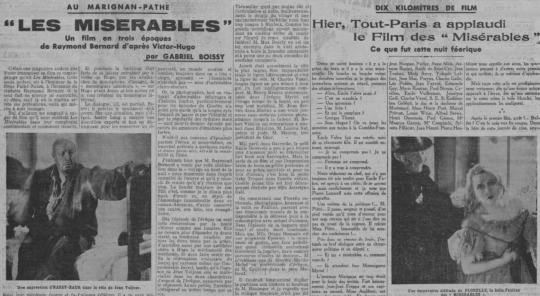
Comoedia, 5 February 1934 (note the picture of Harry Baur by the masthead!) So I learned that the 1934 Les Mis film premiered two nights before a far-right anti-government riot! And you can feel that there was a crisis about to happen in this account of the movie's premiere:
A rough start to the night: there’s the taxi driver’s strike and there’s the parliamentary crisis. The latest information passed from mouth to mouth and most journalists arrived late, bearing the most recent news. “So Emile Fabre is jumping ship?” [Fabre was the director of the Comédie-Française and was apparently being pressured to leave.] “It’s a scandal!” “It’s disgraceful!” “What folly!” “And who is replacing him?” “George Thomé.” [Thomé was a musician as well as the former director the Sûreté.] “Seriously?! They’re going to be cuffing the Comedie-Francaise.” Emile Fabre makes his entrance, followed by his charming daughter. He is just as soon surrounded and interrogated. “I don’t understand! I don’t understand!” “No one understands.” “There is too much to understand.” Our editor-in-chief, who has not always been fond of Emile Fabre, is spotted by his side; he shakes his hand cordially and I note that Pierre Lazareff [editor-in-chief of Paris-Soir] notes this effusive sympathy. A political star enters!...M. [François] Piétri [briefly the Minister of Finance]…thoughtfully and hurriedly, he passes by on swift feet which recently exercised a wise retreat that was, if I dare say, a step ahead of wisdom. He joins Mme. Piétri….It’s impossible to get him to open up!... Caught up in the commotion of the crowd, I hear this brief dialog between a political columnist and a deputy: “And how are your ‘misérables’ doing?” “They are waiting for their Monseigneur Myriel!” The huge Marignan theater is too cramped for this crowd of guests. Luckily Jean-José Frappa and his second in command, Mme. Audibert, thought of everything, took care of everything… And everyone is able to get to the coat check and find his place easily. Because the taxi strike and political events delayed hundreds of people, who then arrived all at once and with haste, this was not an easy task. Who was there? Tout-Paris...I randomly noted with my pencil: Messueirs Paul Abram, Achard, De Adler, Berneuil, Archimbaud, André Aron, Arnaud, Louis Aubert, Aubin, Kujay, Kertée, Azaïs, Bacré, Barthe, Baschet, Baudelocque, Harry-Baur, Bavelier, Robert de Beauplan, Antonin Bédier, Pierre Benoit, Mme Spinelly, Charles Delac and Marcel Vandal, Léon Benoit-Deutsch, André Lang, René Lehmann, Bellanger, Mag Bernard, Tristan Bernard, Jean-Jacques Bernard, Louis Bernard, Dr. Etiënne Bernard (all the Bernards!)...Bernheim, Bernier, Guilaume Besnard, Bétove, Bizet, Blumsteien, Mme Rocher, Boesflug, Pierre de la Boissière, Bollaert, Bouan, Boucher, Robert Bos, Pierre Bost, Paul Brach, Henry Roussell, Charles Burguet, Pierre Brisson, Simone Cerdan, Henry Clerc, Albert Clemenceau, Pière Colombier, Germaine Dulac,Henri Diamant-Berger, Julien Duvivier,Jean Epstein, Fernand Gregh, Mary Glory, René Heribel, Tania Fédor, Alice Field, Jacqueline Francell, Mary Marquet, Florelle, Marguerite Moreno, Françoise Rosay, Becq de Fouquière, Jean Servais, Vidalin, Maria Vaisamaki, Orane Demazis, Rachel Deviry, Rosine Deréan, Jacques Deval, Christiane Delyne, Renée Devillers, Jean Chataigner, Germaine Dermoz, Léon Voltera, Robert Trébor, our director, Jean Laffray, Lucie Derain, Paul Gordeaux, Jean Narguet, Parlay, Suzet Maïs, Antoine Rasimi, Renée de Saint-Cyr, Jean Toulout, Mady Berry, Yolande Laffont, Jean Max, Parysis, Charles Gallo, Léo Poldès, Jean Fayard, Edmonde Guy, Mario Roustan, Paul Strauss, Cavillon, Emile Vuillermoz, Josselyne Gaël, Charles Vanel, S. E. Si Kaddour ben Gabhrit, the duke and duchess of Mortemart, Madame Henry Paté, Marcel Prévost, Louise Weiss, Alfred Savoir, Henri Duvernois, Paul Gémon, magistrate Maurice Garçon, magistrate Campinchi, Sylvette Fillâcier, Jean Heuzé, Pierre, Heuzé, Mona Goya, Simon-Cerf, W.E. Hœndeler, Georges Midlarsky, Michel, Nadine Picard….and others I must be forgetting…pardon me!....Silence!....
In the glow of the half-light from the screen….there are applause! Not since les Croix de bois has a movie been so highly anticipated and now it is time for the verdict….Raymond Bernard can be sure that the audience is rooting for him. Our eyes are full with light and pretty colors. This Paris night is practically magical…and departing from that magic, we are plunged into the great river of les Misérables, into the furious waters of this social storm. Luckily André Lang and Raymond Bernard have made the trip for us. What contrast! From the spectacle of an elegant and distinguished gathering, we move to the misfortunes of Jean Valjean.
The audience picks up on everything that could be an allusion to the present times. But of all these allusions, one stands out. It’s the lament of two gossips, at the moment when the barricades are rising. “What sad times!” “We’ve barely made it through the cholera…and here is the Republic!” Thunderous applause and mad laughter. When, on the barricades, the Republic calls on us to act, the spectators think of other promised actions which haven’t happened and they forget to applaud. But the whole audience is prodigiously virtuous; whenever a good deed is shown on the screen, when some sentence about the heart graces the white canvas, it is punctuated by applause. After the first film, stop!... Time to eat! There’s a mad dash to the punchbowl. In the haste of this day of crisis and running late, many in the audience did not have time for dinner….the buffet, in the blink of an eye, is emptied and the dry drinks make vindictive and impassioned discussions flow. High and low, here and there, everyone was speaking of the Parliment's chances and the intermission bell sounds in an atmosphere charged with electricity. The two other parts of the film, cut by another intermission, each end with a double ovation for Harry Baur, both in the lobby and in the theater. The little Gaby Triquet is passed from person to person towards a chocolate eclair, which she leaves a trace of on the cheeks of Harry Baur. And then as usual everyone rushes to the coat check. Then we go to the fifth floor of the Marignan building. There, in an unoccupied apartment, dinner waits for us. There are more than a thousand of us around little eight-person tables. Ten thousand meters of film, that will make you hungry! Three orchestras pour out waltzes, tangos, and other tunes, while the masters of the hotel fill up our cups. And that continued to six thirty in the morning, in an atmosphere of charming cordiality as each person attested to the pleasure of seeing French cinema accomplish such a feat. Bernard Natan and Raymond Bernard were too surrounded for me to speak to them. Besides, what could I say to them that they haven’t already heard ten times, a hundred times, a thousand times that evening, which was the apotheosis of cinema and of Les Misérables. -Jean-Pierre Liausu
#les miserables#lm 1934#me trying to learn about the 1934 political situation in France via wikipedia
5 notes
·
View notes
Text
Why is Avi Shlaim recycling ‘Baghdad bombings’ theory?
Why is Oxford professor Avi Shlaim blaming Zionist agents for forcing the Jews out of Iraq with a series of bombings? The answer lies in his new childhood memoir, argues Lyn Julius in The Jewish Chronicle:
Avi Shlaim, a professor of history at Oxford, has been no stranger to controversy, attracting criticism from his fellow academics.
Benny Morris has called Shlaim “sloppy”, and slammed his work for “one-sidedness and plain unfairness.”
Now in retirement, Shlaim has just published Three Worlds: Memoir of an Arab-Jew. This is a personal account of his childhood and teenage years straddling three worlds: Iraq, where he was born, Israel where his family resettled, and the UK, where he has lived since 1966.
Aged five, his was a brutal uprooting from a comfortable Baghdad mansion with servants. At a time of rising antisemitism during the 1948 war with Israel, the family fled Iraq to begin new lives in Israel. His father, a prosperous importer of building materials with influential Muslim friends, was completely undone by the move and his much younger wife, once a society hostess, was forced to work as a telephonist.
The marriage broke down. Young Avi brought his emotional baggage to his Jewish school in London, where a friend testifies to the fact he smuggled in non-kosher burgers to spite the headmaster.
During his academic career, Shlaim became more and more stridently anti-Israel. Today he calls it a “colonial settler state”, even though Mizrahi Jewish communities, now comprising over half of Israel’s Jews, predated the Arab conquest and Islam by 1,000 years or more.
The “Arab-Jew” of the title will raise a few eyebrows: the expression is used by some anti-Zionists who deny Jews from Arab countries a separate identity.
But the plaudits have been flowing from reviewers’ pens for Avi Shlaim’s new book. Eugene Rogan, author of “The Arabs” called it the best book he had read all year.
Max Hastings had this to say in the Sunday Times: “This remarkable upside-down tale… A personal story, not a polemic… provocative… His personal odyssey confers on Shlaim an exceptional authority for his words; he can say things that others of us cannot… his thesis deserves to be considered with respect.”
The thesis in question is that “the Zionists” planted bombs in Baghdad to help eradicate the presence of Jews in Iraq. “The shocking truth about the Baghdad bombings of 1950 -51” blares the title of a review by Justin Marozzi in The Spectator.
But Shlaim’s theory is far from conclusive. The only fatal bombing took place in January 1951 (six weeks before the deadline for legal Jewish emigration from Iraq was due to expire) in the Massouda Shemtob synagogue, then being used by “the Zionists” as a registration centre for departing Jews. Three of the five bombs were planted three months after the emigration deadline had passed and caused no casualties.
It is a mystery why “the Zionists” might have thought it necessary to bomb the synagogue when, by late 1950 a backlog of 80,000 Jews, who had already registered to leave for Israel, were stranded in Iraq. Indeed, the Iraqi government toyed with the idea of dumping these Jews on Israel’s border with Jordan or in the Kuwaiti desert because Israel was not shipping them out fast enough.
All the evidence for the bombings points to the nationalist Istiqlal party as the culprit. An Istiqlal member confessed to an Iraqi historian, Shamel Abdul Kader, that he planted the first bomb in April 1950. The Israeli new historian Tom Segev produced evidence blaming the synagogue bombing on Iraqi nationalists.
Iraqi Jews already had reason enough to seek a haven in Israel – rising pro-Nazi sentiment, the memory of a vicious Baghdad pogrom in 1941, the execution of the wealthy non-Zionist Shafik Ades in 1948, arrests, extortion, racist laws persecuting and dispossessing them. A vibrant community of 150,000 is now reduced to three Jews.
But Shlaim claims there was no antisemitism in Iraq until the Iraqis ‘turned on the Jews’ for their alleged complicity with the British invasion of 1941 and the foundation of Israel.
It is a travesty that Shlaim should not only fail to blame Arab regimes for the mass ethnic cleansing of their Jewish citizens, but that his reputation as an Oxford academic should lend ‘exceptional authority’ and respectability to these highly controversial claims,
What lies behind Shlaim’s anti-Zionism? In reviewing ‘Israel and Palestine’ Benny Morris pronounced himself puzzled.
“Many intellectuals, in Israel as in the West, have been moved by the Palestinians’ history and their plight, but at the same time they have remained sympathetic to Israel’s predicament…. In Israel and Palestine, by contrast, there is no sign of any such complex sympathy.
“For Shlaim, Israel and its leaders can do no right. It all begins to seem very personal. What is the source of this bias and this resentment? ‘
It appears that Shlaim’s memoir holds the answer. Israel is responsible for his unhappy childhood, his family’s impoverishment and his broken home.
Read article in full
More about Avi Shlaim

Point of No Return
11 notes
·
View notes
Text

A complex pattern of hedgerows crisscrosses the Normandy countryside.
Soldiers faced some of the toughest obstacles of the war during Operation Cobra: dug-in German troops, terrible weather that frequently prevented air support, and the stubborn French bocage, or hedgerows. World War II-era Normandy was mostly farmland—a patchwork of irregular fields divided by ancient country lanes sunk into the earth after centuries of use. Towering hedgerows guarded each lane, long earthen berms so overgrown with brush and trees they were impossible to see through. The Nazis defended the French interior by using these natural structures as bunkers and barricades. The bocage posed an especially serious problem for advancing Army tanks. The tanks made numerous attempts to drive over them, but as the crested the hilly barriers, their guns would be pointed skyward and their undersides exposed to German anti-tank rockets. But without tank support, Allied forces would be doomed to languish on the Normandy beachheads, unable to penetrate the Axis defense.
Sgt. Curtis Cullin’s hedgerow cutter, or Rhino device, affixed to a Stuart Light Tank, Normandy, 1944. The invention earned its nickname due to the prongs’ resemblance to rhinoceros horns. The most effective solution was also the most famous. Most often attributed to Sgt. Curtis Cullin of the 102nd Cavalry Reconnaissance Squadron, the “Rhino”-tank was a clever repurposing of German defensive hardware. Using scrap steel recovered from a bombed out Nazi roadblock, Cullin fashioned a set of large prongs, shaped like the end of a fork, which he attached to the front of a tank. The tank accelerated up the berm and cut through the thick brush as if it were cardboard.
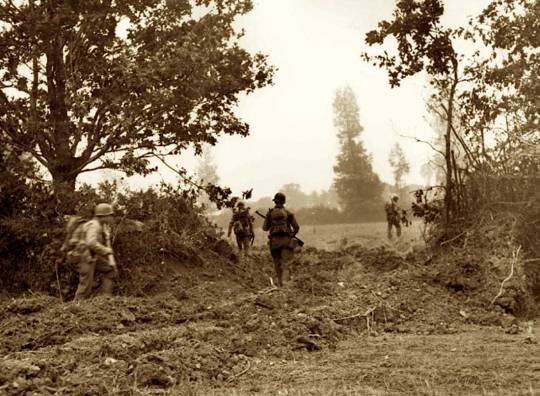
American troops advance through a gap in a hedgerow, carved out by a Rhino tank.
When Gen. Omar Bradley, commander-in-chief of American ground forces during the Normandy invasion, saw Cullin’s invention at work, he ordered them into full-scale production. Soldiers collected the iron anti-tank jacks the Nazis had scattered across Normandy’s beaches and transformed them into hedgerow cutters, which were bolted to virtually every tank in the First Army. Bradley made certain the Rhino tanks were not used until the launch of Operation Cobra. Their effectiveness—further enhanced by the element of surprise—gave the American forces an important morale boost and helped them push deep into German territory. The Rhino tank was so helpful to the invasion that the 29 year-old Sgt. Cullin was awarded the Legion of Merit for its creation.

A native of Cranford, New Jersey, Culin was serving as a tanker with the 102nd Cavalry Reconnaissance Squadron (New Jersey National Guard, the "Essex Troop," 2nd Armored Division) when he came up with the four-pronged plow device created from scrap steel from a German roadblock. When attached to the front of his tank it was successful in rapidly plowing gaps in the hedgerows. Military historian Max Hastings notes that Culin was inspired by "a Tennessee hillbilly named Roberts", who during a discussion about how the bocage could be overcome said "Why don't we get some saw teeth and put them on the front of the tank and cut through these hedges?" Rather than joining in the laughter that greeted this remark, Culin realised the idea's potential and put together a prototype tusk-like assembly welded to the front of a tank. In due course this was demonstrated to General Bradley, who "watched in awe as a hedgerow exploded … to make way for the Sherman bursting through". According to Hastings, Culin, "an honest man", attempted to give credit to Roberts but this was forgotten in the publicity surrounding the invention. Hastings concludes: "[Culin] became a very American kind of national hero".

Sources:
HT: @mixrpixr
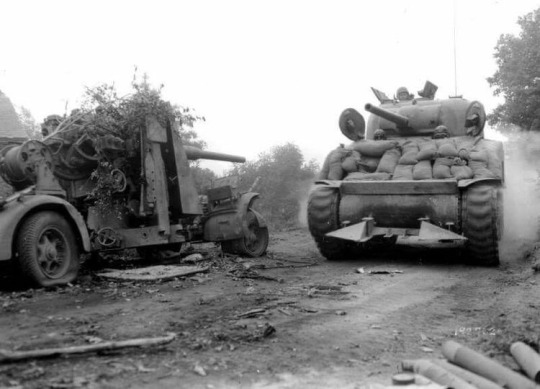

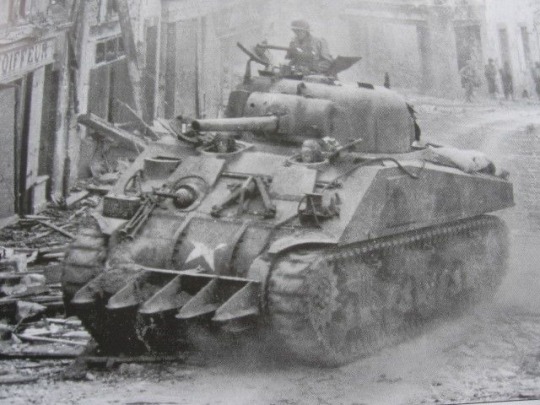
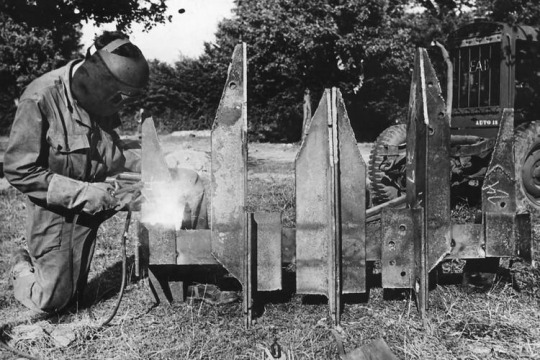
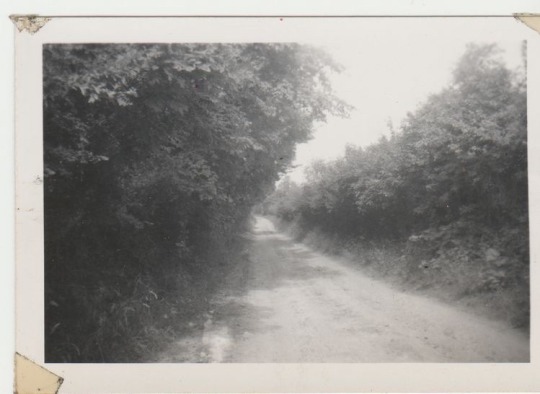
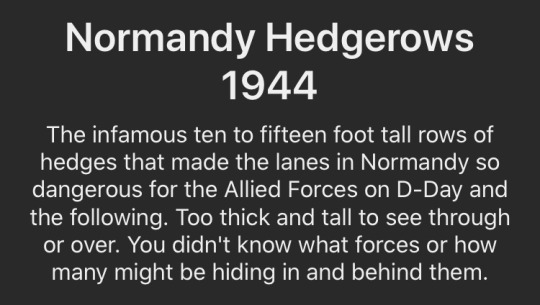
Hedgerow Cutters on Sherman tanks
205 notes
·
View notes
Text
ya know, i wasn’t feeling it in the moment, but looking back and reflecting on it now…pip really should have thrown max under that truck when she had the chance.
#🤷🏼♀️#Idk like it was violent#But I feel like it would have been the best#Then she would have just gotten it over with#Instead of#you know#what she did#pip fitz amobi#max hastings#anti Max Hastings#Agggtm#as good as dead
49 notes
·
View notes
Text
Check in on my (not very realistic) wish list for episode 139
1. Nobody dies in the potential battle against Lucien/the Somnovem? I will be fine with temporary unconciousness but please nobody actually dies? Will they even fight? What was going on with the cliffhanger? I have so many questions!
Hey nobody died! Nobody even went unconscious. Can't believe we have a part 2 to this epic boss fight. This showdown is awesome! At least we know what will happen next episode.
2. The group uses their new eye powers for something (group telepathy will be hilarious, especially accidental) or just in general goof off with their new eyes.
NVM we are doing the boss fight right now
3. Beau or Caleb discover more new eye functions that we have not seen before (antimagic cone anyone? Does the eye location have any meaning? Lucien’s was also on the chest right?)
NVM we are doing the boss fight right now. If the locations mean anything, so far it's not revealed.
4. We get to see more of the party members’ new powers/abilities since they levelled up and got a long rest! Let’s gooo.
MOTIVATIONAL SPEECH thanks Cad. It's a new power we haven't seen before! Caleb knows gravity fissure now, apparently! Fjord and Veth also considered using new abilities before the break. Jester used contagion on Lucien! It was a nice try.
5. They get some sort of contact with/update from the material plane (i.e. their family, Yussa, or anybody else I guess just not Trent please), it’s been a while I wonder what’s going on over there. Has Jester’s parent trap succeeded fully yet? Has the assembly been investigated yet? Has Yussa figured out what the Nein did with his emergency exit gift? How are Yeza and Luc doing in the crime bar? Is the Dynasty looking into Essek? So many possibilities.
NVM we are doing the boss fight right now
6. The M9 succeed in stopping the city from going to the material plane and find a way to potentially destroy it by the end of the episode.
It appears that them plane shifting the crest away actually does ensure that the city cannot return to the material plane, that's great news! Also, I assume destroying Lucien would be a good first step to destroying the city.
7. Beau and Yasha continue to fight like the power couple they are and to indulge in PDA in the flesh horror city (because why not). Bonus: we find out Yasha’s plans for Beau’s red cape/the cape is used by Beau in the episode.
The discussion between Beau, Yasha and Veth LMAO. Oh NO Yasha is fighting Beau again - that natural 1 though! The miss! Another natural 1! The power of love!!!! Yasha also used the battle cry to protect Beau!
8. Fjord and Jester continue to be domestic and supportive of each other in these trying times because they are great. Bonus: more Sprinkle/Artagan mentions or interactions.
Jester and Fjord starting strong with the dirty/natural 20's! Also "I'd rather you wear it" "Fjord, it's so expensive!" They are so cute. Ayy Sprinkle/Artagan both got fed the Heroes' Feast! The excitement over the ring finally working lol. "Imma cast it at 4th level" lol Jester really tried her best to remove his slow and it worked!
9. Obligatory wish for Essek’s fancy dunamancy or magical items (Bonus: STILL hoping to see more high-damage AOE offensive spells that Essek has never cast because of the party placement, dark star anybody?).
The trapped haste spell MmmMm. GRAVITY FISSURE YAY hot spell flavour is hot. THANK YOU for that dispel magic on Yasha Essek you are the best. Nice magic missile but he is out in the open oh nO he is charmed oh no is he going to dark star the party?? Wheww thank you Caleb for the dispel, at fifth level too! He was so going to dark star Lucien if Cad was not pulled.
10. Obligatory wish for Caleb’s polymorph spell on himself or a party member. Actually, let’s expand to any party member’s polymorph! Give me those sweet polymorph interactions.
NVM we are doing the boss fight right now
11. The party tries to reach Lucien by mentioning Molly and Lucien actually having a physical reaction to their words.
Wow that was a physical reaction alright, definitely to Jester and Caleb's mention of Molly's name. Jester's song also had an effect. Everybody is trying yay! Well, it was worth a try. BEAU'S bonus action Gustuv talk made him lose a legendary action WOW. Fjord's, Caleb's attempt also succeeded. In round 2, Beau removed 1 legendary action, followed by Jester
12. Obligatory wish for Essek’s room in the tower (it will stay until it happens).
NVM we are doing the boss fight right now
13. Obligatory wish for Cad being a MVP in and out of combat because he always is.
CAD what a good pep talk I love you. Path to the grave and also the reaction war caster blight, very nice.
14. I NEED MORE RP PLEASE like last week’s high intensity combat was fun but I miss one-on-one conversations give them to me thank you. Longer conversations are even better.
NVM we are doing the boss fight right now, however there was a lot of Molly RP involved.
15. Everybody being super freaked out/creeped out by the terrible flesh city thanks to Matt’s wonderfully detailed and awesome descriptions.
The damaged state of the city, how it leans towards Lucien's cocoon thing and Lucien's transformation... OH NO the stalks not the tentacle stalks.
16. At least one of the party members get mind-influenced/charmed by some effect during the combat (well at least Caleb’s got mind blank and Veth got intellect fortress, but I would be surprised if there was no mind shenanigans).
Well, I knew it would happen. Gaudius, the eye of longing/love that did not affect Beau DID charm Yasha with a failed wis save and Yasha attacked Beau, again. However thanks to Essek it didn't last long!
17. Somebody check in a bit on Essek’s mental state because he is clearly not entirely desensitized as seen from last episode. At least he got a full rest so physically he is fine (just squishy, like wizards are).
Hey Essek got to open up a little bit before their final fight, so that was great.
18. Caleb uses more fire or his customized spells or just any cool spells in general I guess because what’s sexier than wizards NOTHING I’m still hyped from last week.
Gravity fissure already?? Sweet max damage, despite the save! Caleb you can literally just copy any spell you see cast can't you, high int wizard I love you. Also the use of that potion and the scroll were pretty smart too.
19. We learn more about Lucien’s motives and what he is actually trying to do, or more about the Somnovem’s different? motives because I was very confused last episode. Lucien wants to “parent” the Somnovem by bombing them with 10 intuit charges, like okay are you sure you are not trying to kill them? Then again, if that doesn’t severely damage the Somnovem I don’t know what will.
Well we now know that Lucien has all the Somnovem power inside himself now and is still very much wanting to bring back the city - at least he can't right now because of the threshold crest they got rid of last session. This clarifies a lot. I guess the "parenting" was to weaken the Somnovem for him to absorb them all into himself?
20. Obligatory wish for everyone to remain relatively happy and alive by the end of the episode except Lucien, and the episode ends on a terrifying cliffhanger as always.
I mean, should have known that Lucien cannot be killed in 1 session. Otherwise though, what an episode! What a session! Absolutely amazing.
Bonus:
ESSEK IS MAKING A JOKE LMAO I can't with this man, he is also giving everybody spells/gifts, cute - I guess wizards all have the save love language.
CALEB IS ABOVE 100 HP thank you Jester for that 17 roll from Heroes' Feast! I knew you'd do it. The feast was so crucial in their combat too, what a queen. Caleb always be covering his friends in his anti-aberration cone, and burning Lucien's legendary reactions. Great moves.
Veth are you... horny for Lucien??? LMAO
OH NO Gaudius on Essek this is the alternative Essek bossfight timeline OH NO but at the same time YES the angst- oh nvm Caleb thanks lol.
Extra - combat notes for my record:
Saves minus # eyes
Elatis - Excitement, pulling the target 120 ft towards Lucien + eye.
Ira - Rage, fireball effect AOE damage.
Fastidan - Disgust (wilting dull green) necrotic damage
Luctus - Grief (Dex save), slow spell effect.
Timorei - fear effect, but negated by Heroes' feast immunity.
Culpasi - guilt (Con save) disadvantage on saving throws +...
Miramus - (wis save)
Vigilan - the eye that moves/emanates the anti-magic cone
Gaudius - (wis save) charm effect
WHAT A FIGHT! I can't wait for part 2 and hopefully that's Lucien's final form. I did not think that the Molly influence will have such a profound effect, but I sure am glad it did! Everyone was so amazing in this combat, I love it all.
20 notes
·
View notes
Text
In 3.5 as MINION MAKING spell, Animate Dead.
I will admit, this is slightly dishonest, seeing as default "spell level" rule is "if it is on Cleric and Wizard spell lists, default is Wizard" so it should be 4-level. But lets pretend its Cleric doing it.
First of all, its Instantaneous. Once used, it takes no more effort to maintain, and anti-magic cannot drop them down or turn them away.
It makes minions. Cleric, however, can boost their hp per HD by 2 simply by using Desecrate. Add Corpsecrafter for +4 Str and +2 more hp/HD. Add Nimble Bones for +10ft land speed and +4 initiative.
At 15th level you can make 4 Death Slaad Skeletons:
Medium, 15d12+60 (157 avg hp)
Initiative +15
Attack: Claw +14 (3d6+7) or weapon +14
Full attack: 2 claws and bite +9(2d10+3) or weapon +14/+9 (two attacks) and bite
DR 10/magic and silver and lawful, 5/bludgeoning
Fast Healing 5/round (there are no ways to shut it down except for one spell)
Immunity to cold and sonic, energy resistance 5
Str and Dex 25
6 feats that may match what Slaad had in life, in which case bite is instead at +12
and even Minor Ring of Spell Storing provides another one to each one in your party at the very least. Greater ring and Heighten Spell allow each party member to have 4 as well.
And you can equip them. Basic Composite +7 Longbow costs mere 800 gp, which is barely pocket change at this point, and shoots at 110ft increment(with each one reducing attack bonus by 2). Using Greater Magic Weapon on a bunch arrows costs single spell slot and adds +4 enhancement to attack bonus.
And they can freely benefit from all the classic buffs. If needed, a Wizard can open with Celerity + Haste for another attack at highest attack bonus from everyone - max Initiative of monsters at this point is mere +5, so chances of any given Slaad Skeleton going first are pretty decent. Righteous Wraith of Faithful is classic Persistomancy spell for additional melee attack at highest attack bonus(does not stack with Haste).
45 notes
·
View notes
Note
Liking every anti Max Hastings post on my dash
this is a m*x h*stings hate page fr
#holly jackson and her capability in creating the most evil ugly blond men astounds me#max hastings#nav answered ask
2 notes
·
View notes
Text
There are literally SO many other characters to ship people with, WHY MAX?????????
Another day, another fucking Pip x Max fic on the ao3 tag 🤮
Atp I've just grown accustomed to the fact that people are gonna ship that freak with Pip and can't do anything about it because those shippers get highly defensive over that nasty ship. I'm just saying but if you need to go to extreme lengths to defend shipping Pip with a rapist, then maybe the ship is just awful 🤷♀️ (because it literally is. Fuck Max Hastings).
#Anti Max Hastings#Max x casket 2024#agggtm#a good girl's guide to murder#max hastings#pippa fitz amobi
21 notes
·
View notes
Photo

La Petite Anglaise
She parachuted behind enemy lines.
Violette Szabo was a British spy who parachuted into France twice to collect valuable intelligence and paid the highest price for her exceptional bravery.
Born in Paris in 1921, Violette’s mother was French and her father was English. During the Great Depression, her parents couldn’t afford to care for her and she lived with an aunt in Picardy. Finally when she was 11 the family was reunited in London. Violette was a tomboy and natural athlete who loved to compete with her four brothers. Her father taught her how to shoot at a young age, and she was known to be fearless.
Violette grew up in Brixton, and was popular at school due to her bubbly, fun-loving personality and good sense of humor. French was her first language, but she spoke English with a Cockney accent, and also displayed the impish Cockney sense of humor. She left school at age 14 and went to work for a French lingerie company, and then Woolworths.
When WW2 broke out in 1939 Violette was selling perfume in a department store. She immediately joined the Women’s Land Army, a volunteer force of agricultural workers to replace men who were called up to battle, and was sent to pick strawberries in Hampshire, then to work at an armaments factory in London.
In 1940 Violette’s French mother sent her to a Bastille Day parade in London, and told her to bring a homesick French soldier home for dinner. She met Etienne Szabo, a decorated non-commissioned officer in the French Foreign Legion and after a whirlwind 42-day romance, they got married. She was 19, he was 31. They had a week honeymoon before Etienne left to join the Free French fight against the pro-German Vichy regime.
Violette became a switchboard operator in central London during the German blitz. Bored with her job and itching to join the fight, she joined the Auxiliary Territorial Service, the women’s branch of the British Army. She underwent an intensive training program in Leicester and was then assigned to an Anti-Aircraft Regiment. Soon after she discovered she was pregnant, so she returned to London where her daughter Tania was born in June 1942. Three months later, Violette learned that her husband had been killed in action, fighting the Axis powers in North Africa, without ever meeting his baby daughter.
Violette was more determined than ever to fight the enemy that killed her husband. Speaking both English and French without an accent, she was recruited to train as a field agent in the Special Operations Executive, a British intelligence and espionage agency. She was given security clearance and went to a special training school in the Scottish Highlands in the summer of 1943 where she studied navigation, weapons and demolition. She passed the course, and went on to more advanced training at the SOE “finishing school” in Hampshire, where she learned cryptography, weaponry, survival skills, how to evade capture, and how to escape if captured. British journalist Max Hastings wrote that Violette was “adored by the men and women of SOE both for her courage and endless infectious Cockney laughter.”
The last stage in training was parachute jumping, which was taught at an airport near Manchester. Violette badly sprained her ankle on her first jump, but after several weeks to recover she tried again and passed.
On April 5, 1944, Violette was flown from a Royal Air Force station in Bedfordshire in a B-24 Liberator bomber and parachuted into German-occupied France. She had a fake identity as a French secretary, and a mission to act as a courier for the Resistance. Her fellow anti-Nazi fighters called her “La Petite Anglaise” (The Little English Woman) as she was only five feet tall. She gathered intelligence and carried out reconnaissance, and the information she collected helped the Allies identify German bombing targets. She returned to England, and was soon being sent on an even more dangerous mission. Knowing the dangers, she made a will and cried as she said goodbye to her daughter and her mother.
Violette parachuted back into France on June 8, 1944, right after the D-Day landings. Unfortunately, this trip was not as successful. She was in a car with two members of the Resistance when they hit a German roadblock, which led to a shoot-out. Violette was wounded and captured. Despite being injured, she was taken to the German military prison, where she was tortured, but refused to give up any information about her associates. She was seen twice a day limping across the courtyard to face brutal interrogations. As her health worsened, Violette was sent to the notorious Ravensbruck concentration camp for women in Germany. While there, she was beaten, starved, and possibly sexually assaulted. Finally, in early 1945, Violette was taken to “execution alley” and shot in the head. She was 23 years old.
After her death, Violette was honored by her country with the presigious George Cross, a medal for bravery created by George VI in 1940. Violette remains one of only four women in history to receive the George Cross. It was presented to her five year old daughter Tania in 1947. Violette was also awarded the Croix de Guerre by the French government in 1947. She and her husband Etienne were the most decorated married couple of World War II, and their exceptional bravery cost them their lives.
After the war, Violette’s parents emigrated to Australia with Tania. In 1958, Violette’s incredible story was made into a movie, “Carve Her Name With Pride.” Tania described her mother’s life as “short but lived to the full, with. much happiness, joy, some deep sadness, and great endeavor.”
For bravely parachuting into Occupied France – twice – and helping defeat the Germans, we honor Violette Szabo as this week’s Thursday Hero.
Accidental Talmudist
28 notes
·
View notes
Text
Ignition.
It’s a beautiful day. The rising sun has sent all but the most foolish and foolhardy into their hives until dusk, as usual. Which is why it’s perfect for making dead drops of your deconstructive literature in your hometown. There’s a little place you stash them, right near the town square, and there’s a brick you flip around whenever you make a drop, carved to indicate that something is there for those that look. And whenever you go back and look they’re gone, so you know some people have found them. In fact you’ve met a scant few of them, and it gives you hope that what you’re doing matters. A satchel full of the booklets is resting at your hip right now, and you’re hoping that if any of your topics really strikes a chord, it’ll be this one.
As usual, well... This is Beforus. It’s idyllic. Almost unnervingly so. But right as you’re about to open up your little stash, having just ducked out of your alley shortcut, Something happens.
An imperial drone spots you.
Of course, you don’t know that right away. No alarm blares. Your hand is buried in your bag when you hear the thud of it landing right by you. Right by you. It’s only feet away, and saying you jumped is an understatement. It sort of towers over you, you’ve never been this close to one before you realize, and it’s staring you down. Very briefly you consider reaching for the pocket firearm Meenah sent you, but you can’t imagine that doing... Well, goddamn anything really.
“CITIZEN SUSPECTED FOR ILLEGAL ACTIVITY.” It doesn’t really have facial expressions, and its voice is emotionless. It’s sort of inscrutable. “YOU ARE BEING DETAINED, DO NOT RESIST.” It reaches one of its huge, beefy arms for you, and you sidestep it in a panic. You’re pretty sure it doesn’t like that. As confident and collected as you like to usually act, opening your mouth and speaking is the hardest it’s ever been.
“I’m not going anywhe-”
“DO NOT RESIST. THIS IS YOUR FINAL WARNING.” You wince, and when the hulking frame moves to take a step, every single warning bell in your body blares at max volume. Retreat, Porrim. Now. Closing the distance, it reaches for you again and you react by sprinting under its arm and past it, booklets fluttering out of your satchel. You book it deeper into town, hoping you can duck into another alley before it’s caught up and make it lose track of you. You’re no athlete, but your gifts let you move faster than most trolls who practice for it.
The drone catches up in fifteen seconds.
And you don’t even hear it behind you as it gives chase, not until it’s nearly on you and the sound of burning thrusters makes you look over your shoulder in wild confusion. Its arm is outstretched, and in your dumbfounded shock you stop to try to duck under it, or step to the side, or grab it and hold it at bay, or SOMETHING. All you manage to accomplish is letting it ram into you full speed and crush you against the wall of a building.
When you come to a few seconds later, it’s just staring you down it seems like, making that heaving motion they do like they’re always heavily breathing. You’re making the same motion, actually, because you are heavily breathing. You’re in so much pain. Everything got crushed. This “hand” is as big as your torso, and in its haste to get you it was imprecise. Its sharp thumb is jammed through your side, having gored a chunk out of it. You’re in so much pain. As a Beforan, injuries like this are basically unheard of. You’ve had some scrapes. But you’ve never seen so much of your blood leave you so quickly, and that’s with the wound plugged. Half of its hand is green. Half of your body is green. The ground around you is green. You’re in so much pain. You can hear its other fingers scraping through the wall behind you, further worsening the structural damage your impact caused. You’re familiar with the feeling of a broken rib. You’re familiar with the feeling of most of your rubs being broken at the same time. You were not, until this moment, familiar with the feeling of having your shattered rib cage squished even further. You’re in so much pain. It pales in comparison, but with what few thoughts you can have clearly you can’t help but be reminded that the only time you’ve even come close to feeling this indescribably awful was that accident right before you discovered you were a- Oh. That’s right.
You’re a fucking rainbow drinker.
Your arms have been free this whole time. It’s looking at you, glowering, yelling something about taking you somewhere for something. You can’t understand it. You can’t understand anything right now. But as the adrenaline hits, all at once with a snarl you raise both of your arms and all your rage, your fear, your pain is channeled into turning on your glow. And it’s bright, like you’re the epicenter of a flashbang. Your skin burns now and the light fades fast, but the pain blends in with everything else by the time you’ve brought your fists down on either side of the top of the drone’s arm, shattering its carapace and splashing black blood onto your arms.
By the time it’s over the stun of the light, the drone is reeling slightly from having its limb crushed, and that’s all the opportunity you need. With its grip slightly loosened you grab on to the arm, barely even feeling the jagged edges slice your hands, and push it away from you, causing even more of your blood to gush out, more than a human could ever safely lose. And then you bend it away from you, the way the drone’s elbow isn’t supposed to go. It’s sort of a satisfying crunching noise when you break its joint, burning sensation resurfacing in your muscles. And as you brace, leg coming forward, and the drone braces against the pain, knee hitting the ground, you twist brutally, like you’re turning the wheel of a ship, and snap the limb clean off.
Every single one of your muscles feels like it would implore you to stop moving. You’ve never wanted less to stop moving. With the creature, the monster, rearing back, you flip the arm you’ve stolen and get a solid grip on what used to be the elbow. The blood is flowing out of it like a storm drain as you shakily lift it up. And then you bring it down at an angle, flat back of the hand bouncing off of its head, cracking it a little and breaking a few of the spikes. You carry the momentum into steadying it directly over you and then bring it down again, straight down, on top of the drone’s skull. And then again. And then again. And again. And again. Again. Again. Again. You haven’t had a single thought since you crashed your own fists into it, but you realize now that you’re growling something out, and you use it to punctuate your last few blows.
“I’M! NOT! GOING! ANYWHERE!” The hand on your impromptu weapon has been demolished, beaten down to a stub, and the end of the limb below the wrist is doing little better. As you lift it for the last time, you see the head, crumpled flat in the crater you’ve created between the drone’s shoulders and bereft of all spikes. Finally you drop your bludgeon, and you start thinking again, you start thinking faster than you can keep up with. You can’t stay here. You can’t stay on this planet. You’re sure that more drones will be on their way soon enough, however they signal each other, but surveying the scene you see your booklets, half of them ruined with either black or green blood. You see the poor building, which you’re too delirious to be able to glean what it’s even the wall of. Through your bleary eyes, you think you see commotion stirring through some of the windows around you. You can’t just leave the scene like this.
You scoop up some of your aggressor’s blood. Enough of the wall is still flat that it will make a fine writing surface. You drag your hand across it to make four short, large words. And then sign it off in your own blood underneath. You don’t normally quirk for this alias. But you think it’s appropriate here.
You don’t run away from the conflict site. You don’t jog. But you’ve got enough strength left in you not to limp for a while, even when all the pain comes flooding back. When the few trolls with sungoggles finally catch wind of the commotion and step outside, they see a dead imperial drone, kneeling, missing an arm. A disaster of two colors of blood. Some loon’s bold anti-empire booklets leaking out of an abandoned satchel. And a brick wall, with a message.
DO+
NO+T
GO+
QUIETLY
-M
#blood //#violence //#gore //#injury //#idk porrim gets real fucked up#Action Post#ask to tag /././#Fire on Beforus
7 notes
·
View notes
Photo
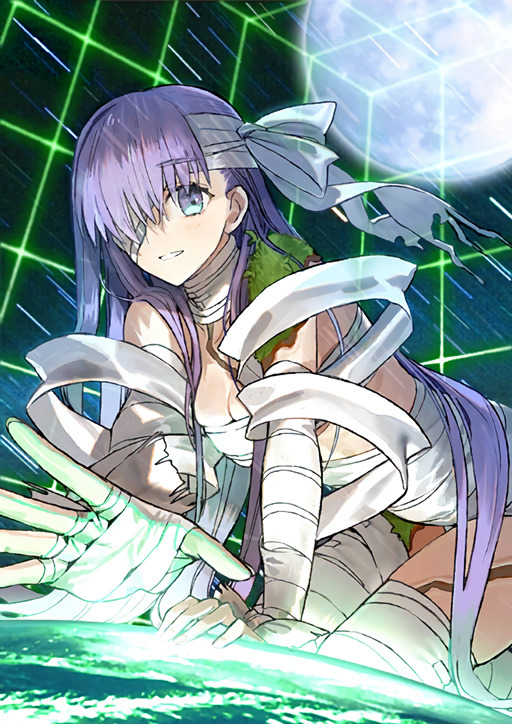
Big Grill in Little Chaldea - Review
Overview: KP is the best unit of 2019 and she was released back in March. Also it’s only May.
Kingprotea is the Alterego G of the Sakura Five, a High-Servant composed of multiple Earth Mother Goddesses, particularly everyone’s favorite Beast II, Tiamat, as indicated by her final ascension.
KP’s kit is unique, encouraging a lot of creative and non-conventional team building due to the versatility of the Alterego class and KP’s own kit. In a lot of ways, she’s self-sufficient out of the box, boasting a power level that is essentially unchallenged by other units in the game, without even taking into account her active skills or Noble Phantasm. I consider her the best Alterego in the game, at least for most situations.
Generally speaking, her kit is pretty simple almost deceptively so when you take into account her unique self-buffs, widely-varying in length cooldowns, and situational buff procs. Essentially, she’s a bruiser-type unit who can take and deal significant amounts of damage.
Under the Hood: Kingprotea is a Buster unit, boasting two single-hit Buster cards, two triple-hit Arts cards and a lone triple-hit Quick card. Her extra attack hits six times. She has a Buster Noble Phantasm that is area of effect and shares some level of similarity to Ishtar’s Noble Phantasm in that it has a low scaling, but regardless can deal serious damage.
Generally speaking, KP fits in well with almost any Buster team, although, I would personally discourage the choice to use her with Osakabe.
Kingprotea’s stats are monstrous. She boasts the second-highest attack stat in the game, a whopping 13835 at level 90 with silver Fous. She’s no slouch in terms of HP either, with a 14338 pool at level 90, but that starting point is largely negligible for our headpat goddess.
Generally speaking, all of KP’s cards are awesome, save for her lone Quick card, which honestly isn’t even that bad.
Passive Skills: KP is honestly overloaded in this department. In my opinion, she has the best set of passives currently in game. Every single one, roughly equates to a relatively generic Craft Essence of decent potency.
Mad Enhancement A+ is starting off extremely strong. An 11% Buster up for free on a Buster unit makes most Merlin targets jealous. This is most often found in Berserkers, who balance their offensive power with a certain level of frailty, KP doesn’t share that general weakness.
Independent Action B is probably KP’s weakest passive. An 8% free boost to critical damage really isn’t a bad boon at all, as we’ve been in a crit meta since Merlin was released, but KP really isn’t a crit unit. With that in mind, she totally can take good advantage of this, depending on your team.
Territory Creation EX is extremely strong. Honestly, most units would kill to have KP’s passives up to this point. A 12% boon to Arts performance at all times, turns KP’s Arts cards from “good” to “very good.”
Divine Essence A is KP’s defensive skill. 25% debuff resistance makes her just a little more robust and reliable and 250 free damage on every attack is nice, even if it largely won’t make too much of a difference at high-level content. I guess at least it adds up over time?
Active Skills: At first glance, KP’s actives are odd, but upon closer inspection, they are both potent and grant good synergy with the rest of her kit.
Huge Scale C is one of KP’s id_es skills. This grants her a unique “Infinite Growth” buff that grants her stacking max HP buffs with a permanent duration every turn. These buffs start at 2000 HP and at max level reach 3000. KP can stack up to 10 of these for a max boon of 30000 HP. This acts as faux-healing of sorts and it also fuels some of her other abilities. It has a 10 turn CD.
Infantile Regression C is KP’s internal engine of sorts. It eats her “Infinite Growth” buff and any stacks that she has acquired in order to give her a turn of skill haste and grant her NP charge based upon the number of stacks she consumed. The NP charge ranges from 10 to 20% per stack, resulting in a maximum NP charge effect of 200%. It winds up with a 5 turn CD.
Monstrous Strength EX is an excellent self attack buff. 40% for 3 turns on a 5 turn CD is nothing to scoff at, especially with a skill haste effect. With certain compositions, it becomes possible for two of these buffs to be active at once, granting our headpat goddess a nightmarish 80% attack up atop the unit with the second highest attack stat in the game. This is without taking into account other party members, as this can be easily achieved with KP and the Atlas Academy Mystic Code. (Oh pardon me, I’m getting ahead of myself.)
Noble Phantasm:
Airavata King Size: The Colossal Figure Coming Out From The Ocean of Life
E Rank, Anti-Unit Noble Phantasm
KP headpats the enemy party. If they’re not dead, she consumes her stacks and pats them again. If she needs a little more oomph, she waits a turn after the consumption.
This attack is a 5 hit Buster NP. It increases own Buster performance between 20 and 60% depending upon overcharge and if KP has so much as a single stack of growth when activated, it grants her an additional 20% Buster buff. Both of these buffs last the turn and KP is capable of Buster Brave Chaining.
This Noble Phantasm is very very good and provides perfect explanation for KP’s surface level weirdness.
Bond 10 CE:
These Are, Both Arms of Full of... is a perfect CE for KP. Depending on your choice of usage of her, it may not always be optimal but, no matter how you use her, it is quite potent. This CE increases her Buster performance by 20% and additionally increases her attack by 20% if she has at least one stack of growth. With this CE equipped and without any additional party members, KP can Buster Brave Chain with an 100% attack buff and a 71% Buster performance buff while boasting base attack second only to Alterjeanne.
Tips and Tricks:
KP is incredibly hard to claim a definitive means of use for. She can solo, she can be a primary damage-dealer, she can be a crit unit, she can be an NP spammer... honestly, she can fill a lot of roles. Consequently, claiming a best CE for her can be tough, as it depends on what you want her to do. In general, her bond CE probably has the best effect for economy, challenged only by The Black Grail (especially if you want her to NP spam.)
I like to use her to fight Riders, who can sometimes discourage conventional support-type units. A typical comp includes Florence (shout out to @acclerated-railgun) and some sort of tank, typically her sister-Alterego Passionlip. A very good argument could be made for Leonidas, especially if you happen to have his Bond CE. Essentially, Florence and the Tank keep everything running smoothly while KP winds up to give headpats of destruction, powered by Angel’s Outcry and sometimes with a nice bounty of crit stars. Mashu is also an excellent choice.
With Merlin and Tamamo you can create a potent NP spammer that is entirely overloaded with buffs. Tamamo’s party skill haste and KP’s own haste skill enables the 80% attack up (or 100% with Merlin) that I mentioned earlier and you can combine that with The Black Grail’s NP damage boon, with the demerit all but entirely mitigated by infinite growth. The result is a KP who can consistently hit like the Beast she is partially derived from and with party upkeep and defense options that resemble a dedicated stall team.
Waver and Andersen legitimately go with anything. If the only rare unit that you happen to have is KP, Andersen + Merlin is a top tier Buster-Crit support set up that will enable her.
If you’re really going for broke, Shakespeare isn’t a bad unit to pair her with, although the previously mentioned units are all better picks.
She works decently well with fellow Sakuras, Passionlip and Summer BB. Where Passionlip tanks and heals and Summer BB controls and enables broken KP Buster Brave Chains.
In terms of Mystic Codes, Fragments of 2004 is an excellent choice, particularly in tandem with her Bond CE and/or a Leonidas tank for optimal application of the stars from Thermopylae Enomotia.
The Atlas Academy Uniform freely enables the attack shenanigans that I mentioned before, I’d recommend it when trying to solo with a CE like Duke of Flames or Demonic Bodhisattva. (Less optimal for that regard is Before Awakening and even worse at that is Steel Training.)
The Arctic Chaldea Uniform is a great choice for general application, though it is the hardest Mystic Code to level.
KP is weak to buff removal, so running her with Tamamo and Tropical Summer can help mitigate that.
The Chaldea Combat Uniform, New Years and Chaldea Uniform are also viable for less niche reasons. Also Anniversary Blonde, because Buster.
Recommended CEs:
Her Bond CE and The Black Grail are probably the most optimal. Throwing a Crit CE if you’re trying a crit build with likely be beneficial. I would personally recommend Knight’s Pride as she has more than enough HP to offset the defense demerit.
I personally think you should try and focus on NP damage, as her NP scaling is low and you want to fire her NP as often as possible when trying to do damage, even in crit-focused teams.
With that in mind, anything that buffs Buster or attack in general is likely at least usable on her.
Any CEs I mentioned earlier are also good choices, especially in the context I mentioned them.
Conclusion: If there was ever a Servant to Grail for gameplay, KP is it. She can literally make the most of any base attack increase with her own absurd self-buffing.
She’s also an adorable giant headpat goddess with a completely distinctive sprite.
Also her kit is so unique that using her feels completely different from every other unit in the game. Even other high damage units or AoE Alteregos don’t feel anything like Kingprotea.
In a lot of ways, you can really just try stuff with her, a lot of it works a lot better than you’d think it would on the surface.
She’s really good fun honestly, and I can’t recommend her enough.
#fate grand order#kingprotea#alter ego#review#headpat goddess#tiamat#florence nightingale#merlin#hans christian andersen#william shakespeare#leonidas I#passionlip#summer bb#waver velvet
32 notes
·
View notes
Link
via Politics – FiveThirtyEight
Former special counsel Robert Mueller gave short, clipped answers in front of two House committees last Wednesday, and he provided almost no new information about his investigation into the 2016 election and Russian interference during his testimony. But his appearance nonetheless seems to have bolstered the movement on Capitol Hill to impeach President Trump. Since Mueller testified, more than a dozen additional Democratic House members have come out in support of at least beginning a formal impeachment investigation. The total number of House Democrats favoring impeachment has reached about 109, according to lists from The New York Times and The Washington Post — nearly half of the 235-person Democratic caucus.1
In fact, it’s likely that there will soon be a pro-impeachment majority among House Democrats. A Democratic majority for impeachment is potentially (more on this in a moment) an important milestone in the months-long debate over exactly how Democrats should react to the Mueller’ Report, which included descriptions of a number of actions by Trump that could constitute obstruction of justice.
Why is a pro-impeachment majority likely? Because there are plenty of Democrats who have yet to come out for impeachment but who face similar political pressures to those who already have. The 109 Democrats who currently favor impeachment, not surprisingly, mostly represent very liberal districts; on average, Trump lost those districts in 2016 by about 38 percentage points. (Trump lost the average Democratic-held House district by 28 percentage points, and he lost the average district with a member not supporting impeachment yet by 20 points.) Of the 126 Democrats who are not yet on board with impeachment, 29 represent districts where Trump lost by at least 38 points. If just nine of those 29 embraced impeachment, the pro-impeachment wing of House Democrats would have a majority.
Impeachment holdouts in very blue districts
Democratic members who don’t support impeachment in districts that Hillary Clinton won by more than her margin in the average pro-impeachment district*
Name District Clinton’s Margin Nancy Pelosi CA-12 +78 John Lewis GA-5 +73 Gregory W. Meeks NY-5 +73 Hakeem Jeffries NY-8 +71 Frederica Wilson FL-24 +68 Alcee L. Hastings FL-20 +62 Eddie Bernice Johnson TX-30 +61 Jerrold Nadler NY-10 +60 Anthony Brown MD-4 +58 Elijah Cummings MD-7 +56 Albio Sires NJ-8 +54 Anna G. Eshoo CA-18 +53 Ro Khanna CA-17 +53 Hank Johnson GA-4 +53 Eliot Engel NY-16 +53 Zoe Lofgren CA-19 +51 Adam Schiff CA-28 +50 Marc Veasey TX-33 +49 Jimmy Panetta CA-20 +47 Sylvia R. Garcia TX-29 +46 Mike Thompson CA-5 +45 David Scott GA-13 +44 Brad Sherman CA-30 +43 Terri A. Sewell AL-7 +41 David Price NC-4 +40 Linda Sánchez CA-38 +40 Gerald E. Connolly VA-11 +39 J. Luis Correa CA-46 +38 Judy Chu CA-27 +38
*Clinton won pro-impeachment districts with an average of 37.6 percentage points.
Sources: The New York Times, the Washington Post
Those 29 members, representing such liberal districts, are likely to face some pressure to get on board. Polling suggests that while a majority of Americans oppose impeachment, a clear majority of Democrats favor it. In a congressional district where Trump lost by 38 percentage points, the sentiment is likely to be heavily in favor of impeachment.
It’s not that these House members will necessarily face primary challenges if they don’t join the impeachment push. But with the House now on a six-week recess, it’s likely that many of these members will be asked about impeachment by their constituents in their home districts, and I suspect few of them want to defend Trump’s conduct on the merits. So they are likely to suggest that impeachment will be both divisive to the country and relatively useless, since the Senate almost certainly will not remove Trump from office.
Some of these members can probably sustain an anti-impeachment position along those lines. But others will likely buckle and join the pro-impeachment push.
For now, though, those 29 members in heavily-Democratic districts who have not yet supported impeachment comprise an interesting group. Nearly all have at least one of three characteristics: They are black; they are from California; they are in Democratic leadership.
That members in leadership are holding out makes sense. As long as House Speaker Nancy Pelosi maintains that impeachment isn’t the best course, her leadership team is likely to hold that position. (Incidentally, Pelosi is the Democratic holdout in the most anti-Trump district — Trump lost there by 78 points.)
The California and black blocs present a more nuanced case. I suspect the California members, in particular, both respect Pelosi’s judgment that impeachment is politically unwise and may be holding off support for impeachment in deference to her. Many of the black members are close to Pelosi, as well. But I wonder if we are also seeing the same practical streak (Trump is not actually going to be removed) among Congressional Black Caucus members that we are seeing among black voters, who are embracing Joe Biden in part because they perceive other Democratic presidential candidates as less safe bets against Trump in a general election. Maybe a CBC member can convince his or her constituents, who are likely extremely opposed to Trump, that a failed impeachment process could help the president win a second term.
Whatever their rationales, I don’t think nearly all of these people can hold off on embracing impeachment. And there is another bloc of more than two dozen Democrats who are not yet in support of impeachment and represent slightly less blue districts where Clinton still won by at least 20 percentage points in 2016. These members don’t face any real electoral danger and are also in strongly liberal districts, so their constituents may push them to embrace impeachment.
What about the rest of the Democrats — those who aren’t in very liberal districts? Their behavior gives ammunition to both the anti- and pro-impeachment forces in the party. Broadly, this bloc is wary of impeachment, reinforcing the stance of Pelosi and the anti-impeachment group. Of the 64 Democrats who represent districts where Clinton won by 10 points or less (including districts won by Trump) just 14 members support impeachment. Only one (New Hampshire’s Chris Pappas) of the 31 House Democrats in districts won by Trump in 2016 supports starting the impeachment process.
Where Democrats in purple and red districts stand
Democratic House members in districts that Hillary Clinton either won by 10 percentage points or less or lost
Name District Supports Impeachment Clinton’s Margin Kathleen Rice NY-4 ✓ +10 Jennifer Wexton VA-10 +10 Dean Phillips MN-3 +9 Raul Ruiz CA-36 +9 Gil Cisneros CA-39 +9 Jason Crow CO-6 +9 Chrissy Houlahan PA-6 +9 Mike Levin CA-49 ✓ +8 Andy Levin MI-9 ✓ +8 Sean Casten IL-6 ✓ +7 Tim Ryan OH-13 ✓ +7 Jim Langevin RI-2 +7 Stephanie Murphy FL-7 +7 Katie Hill CA-25 +7 Thomas Suozzi NY-3 +6 Ann Kirkpatrick AZ-2 ✓ +5 Katie Porter CA-45 ✓ +5 Steven A. Horsford NV-4 +5 Daniel Kildee MI-5 ✓ +4 Jahana Hayes CT-5 +4 Kurt Schrader OR-5 +4 Kim Schrier WA-8 ✓ +3 Joe Courtney CT-2 +3 Charlie Crist FL-13 +3 Josh Harder CA-10 +3 Ann Kuster NH-2 ✓ +2 Harley Rouda CA-48 ✓ +2 Colin Allred TX-32 +2 Tom Malinowski NJ-7 ✓ +1 Sharice Davids KS-3 +1 Lizzie Pannill Fletcher TX-7 +1 Susan Wild PA-7 +1 Peter DeFazio OR-4 ✓ 0 Angie Craig MN-2 -1 Josh Gottheimer NJ-5 -1 Susie Lee NV-3 -1 Mikie Sherrill NJ-11 -1 Cheri Bustos IL-17 -1 Tom O’Halleran AZ-1 -1 Chris Pappas NH-1 ✓ -2 Lucy McBath GA-6 -2 Sean Patrick Maloney NY-18 -2 Conor Lamb PA-17 -3 Elaine Luria VA-2 -3 Haley Stevens MI-11 -4 Cindy Axne IA-3 -4 Abby Finkenauer IA-1 -4 David Loebsack IA-2 -4 Lauren Underwood IL-14 -4 Jeff Van Drew NJ-2 -5 Ron Kind WI-3 -5 Andy Kim NJ-3 -6 Elissa Slotkin MI-8 -7 Abigail Spanberger VA-7 -7 Antonio Delgado NY-19 -7 Ben McAdams UT-4 -7 Matt Cartwright PA-8 -10 Jared Golden ME-2 -10 Max N. Rose NY-11 -10 Xochitl Torres Small NM-2 -10 Joe Cunningham SC-1 -13 Kendra Horn OK-5 -13 Anthony Brindisi NY-22 -16 Collin C. Peterson MN-7 -31
Sources: New York Times, Washington Post
Democrats, in theory, should be concerned about protecting the members who are most essential to the party having a majority in the House. Their opposition to impeachment sends a strong signal about how they’re reading the politics in their home districts. Also, an impeachment resolution would not get the necessary 218 votes to pass without most of the 31 Democrats in Trump districts voting “yes” on it, assuming all Republicans stand with the president. A failed impeachment vote in the House, never mind the Senate, would be quite embarrassing for Democrats.
On the other hand, pro-impeachment members like New Jersey’s Tom Malinowski and California’s Katie Porter, who both won GOP-held districts in November, give the pro-impeachment forces in the party a valuable talking point: If Malinowski (Clinton won his district by just 1 percentage point) supports impeachment, why is New York’s Gregory Meeks (Clinton won by 73 points in his district) not on board? The pro-impeachment stance of members like Porter is part of the reason why I think more members in “safe” districts will be effectively forced to join her.
But here’s the thing: A majority of House Democrats being for impeachment doesn’t inherently mean anything. Even after that majority is reached, maybe Pelosi still keeps impeachment proceedings on ice. Maybe some of the pro-impeachment members know that they are taking a stand with no consequences, because Pelosi has assured them privately that she will stop impeachment from going forward no matter what.
At the same time, pro-impeachment sentiment, at least among Democrats, seems to be building. It’s easy to imagine that the dam has broken and that House Democrats, particularly those representing very liberal areas, feel like they can simply no longer defend their opposition to impeachment. If, say, 150 Democrats are for impeachment a month from now, watch out. Pelosi may not be able to sideline that big a pro-impeachment bloc.
4 notes
·
View notes
Text
Batman TAS: Heart of Steel (Part 2)
“I do wish your toys wouldn’t play so roughly with you, Sir.”

Episode: 39 Robin: No Writer: Brynne Stephens (Brynne Chandler) Director: Kevin Altieri Animator: Sunrise Airdate: November 16, 1992 Grade: A
Picking up where we left off, and things don’t appear to be off to a stellar start. Batman escaping the grabber that is installed incredibly high up on the cave ceiling seems anti-climactic. Because after that, HARDAC just gives up. Batman starts to track its location, and it disconnects from his system, ending the moment. What the hell, HARDAC. Didn’t you just have control over everything? You couldn’t have locked Batman out entirely and prevented him from even getting that far? Luckily this segment ends with a pretty funny callback to Part 1 from Alfred, and from here things are awesome the entire way. I think that the cliffhanger last time was only there to be a cliffhanger and get ratings for Part 2. I guarantee it was an afterthought. But whatever, it’s out of the way, now let’s get to the good stuff!
The previous episode was used to set a lot of things up. It had some good moments, but they held off from showing us the major excitement. This episode flies by, and it feels like nonstop action with some of the best imagery we have yet to see. I’m so happy with how well they nailed the designs of a lot of these robots, and the concept was taken to its max potential. I love the way that the robots (disguised as people such as Bullock, Gordon, Mayor Hill, etc) move around, sometimes walking and talking just like you and me, but other times they leap and scuttle in a way that almost resembles the way the little girl moves in The Exorcist or like the girl from The Grudge. Paired with their glares and those piercing eyes, and it’s easily as creepy as anything on Courage the Cowardly Dog. The most disturbing moment is when one of the robots twists its head all over the place and then follows Batman up the elevator cable. It’s a moment of tension because we know the bot will grab Batman if he doesn’t hurry the hell up and solder through it. It’s a similar feeling to being followed and trying to quickly unlock a door. After Batman solders through, the elevator falls many floors and completely demolishes the robots that were onboard, and we get to see their mangled carcasses. Like with Captain Clown from The Last Laugh, robots give the writers a lot of fun opportunities for violence that is not typically permitted. There’s an earlier scene where a robotic Bullock is thrown onto the Bat-Signal where it gets electrocuted. We see a charge running through it, its hand twitches, and it loses its skin-like shell. Seeing how willing Batman was to deliver this type of punishment to Bullock was a little bit concerning, and we even see Barbara start to cry during the aftermath before they realize that it’s not really Bullock. Beautiful stuff!
During the climax we get a lot of this type of thing all shoved together into one scene. There are explosions galore (I sorta gave up on the fire count that we had going, but if I hadn’t, you’d better believe that this episode would count toward it), some twisted imagery in the form of seeing Bullock and Gordon suspended in a tank of water for observation, and Randa gets part of her face ripped off, revealing a metal skull underneath. It makes Batman jump in fear as he turns around and sees her. While one of Batman’s major talents is scaring the piss out of the criminals he fights, as we know from Scarecrow episodes, he himself is not immune to fear. It’s nice to see him expressing this emotion without the use of mysterious gas.
HARDAC’s motives were fleshed out a lot more, and they are a little cliché. Replacing all humans, eliminating man-made flaws, allowing the world to run smoother, yada yadda. We’ve heard this before. What I find more interesting is Karl Rossum’s role in all of this. What I gathered was that Rossum designed HARDAC to replace certain human-operated functions with robot-operated functions. For example, self-driving cars. He had a daughter that died in a car accident, and so he vowed to rid the world of the possibility of this happening to anyone else. Because he…for some reason…gave HARDAC a free-thinking mind, HARDAC decided to take this plan much further than intended, considering all humans a problem period. They’re too imperfect. Ironic, given HARDAC’s quick downfall, but hey, this is the 90’s. Technology has a long way to go. Anyway, Rossum’s motives are pretty vague, though, so I could be interpreting this wrong, but I like that there are a couple of ways to take it. I can see someone else going more literal and imagining that he wanted to replace drivers with robots, or even some of the more problematic citizens. Who knows. Interestingly, in Part 1, we see Randa using a self-driving car, which I just now remembered. I thought I remembered something too about Randa being modeled after his daughter, but they never mentioned this. Head-canon I guess. I have to ask, is Rossum innocent? He doesn’t seem to be in much trouble at the end, but we have no way of knowing how far he was going with this plan. Yeah, HARDAC went further, but that doesn’t mean that Rossum wasn’t trying to go further than most sane people would, you know? I have a feeling that we’ll never see him again and won’t have to worry about it, but Batman the Animated Series has this way of surprising me.
Barbara Gordon gets more time this half hour, and she’s so rad! Her voice actress (Melissa Gilbert) plays her so well, and combined with the lines, she sounds like she’s incredibly intelligent. How love how she talks to her stuffed bear when she’s by herself, but what she talks about is how she plans on breaking into Cybertron to rescue her father. It combines cute with badass and capable, and she seems to be a strong female role model that any kid could look up to. Not to say that I condone putting yourself into the kind of danger that she did, but hey. You know what I mean. Last episode she may have been an extension of Jim. This episode she broke out of that and felt like something entirely her own. You already know that I know, but for those who don’t know what’s coming (Char), hopefully we’ll see lots more of Barbara! She did mention how much she enjoyed getting in on the action, and Batman told her that she did an excellent job. If that doesn’t sound like a recurring character, I don’t know what does!
I don’t have too-too much more to say, but this episode was way better than I remember. So far, it may even be top ten material. Char loved it too. She said that she was happy that no one died in the end, but jesus, when Possum was fried by HARDAC’s laser, I thought he was going to be left a pile of ash. Never program a super-powerful, free-thinking computer to have weapons like that… You give it a will to be free and a way, what could go wrong?

Get a load of Gordon’s tall mustache.

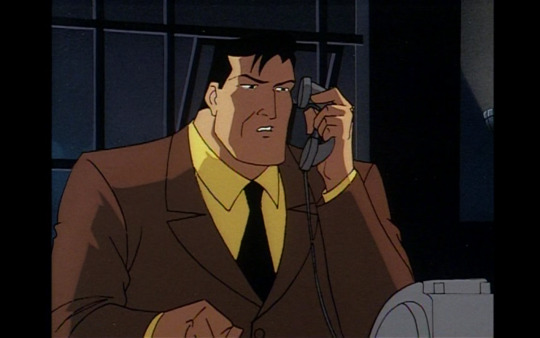
Some of the animation in this one reminds me of The Tick. It’s the line work as well as the eyes. I couldn’t find any info on who did the animation for The Tick, but could it have been Sunrise?
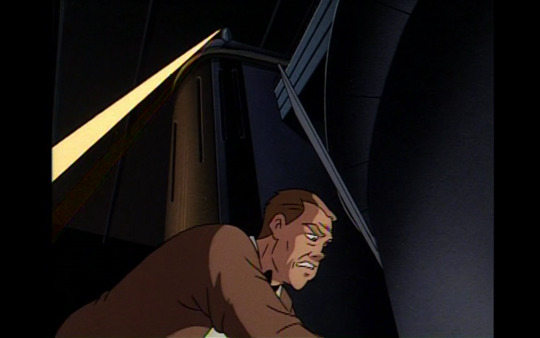
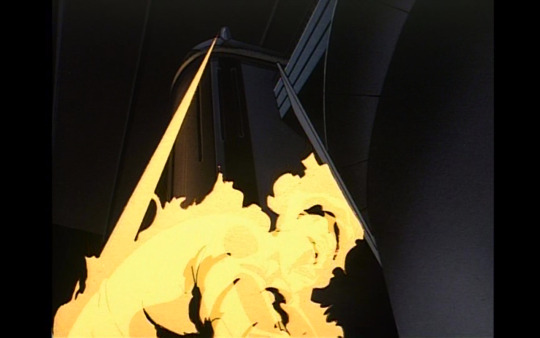

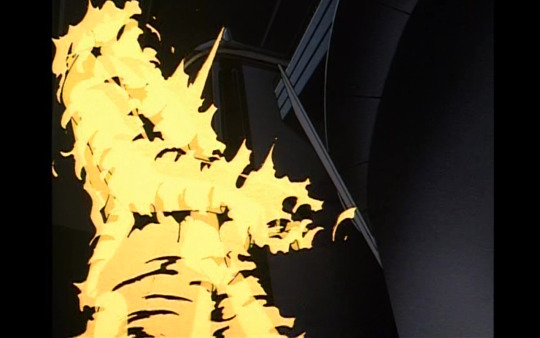
Jesus, he’s not dead? The intensity of HARDAC’s laser blast was shocking, and it looked soooo violent.
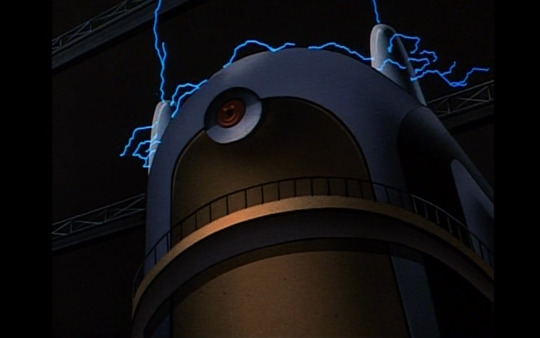
I keep seeing a smiley face on HARDAC’s light/eye/whatever. On purpose?

Basically what I see when I go to the dentist. What creepy lighting! I like how intimate this segment was.
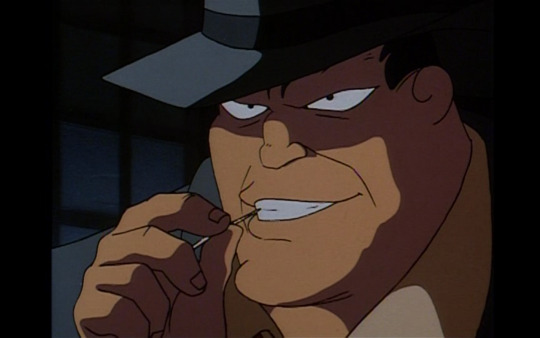

It must be so therapeutic for Batman to get to beat the shit out of the fake Bullock, especially after this shit-eating grin. What a great face!
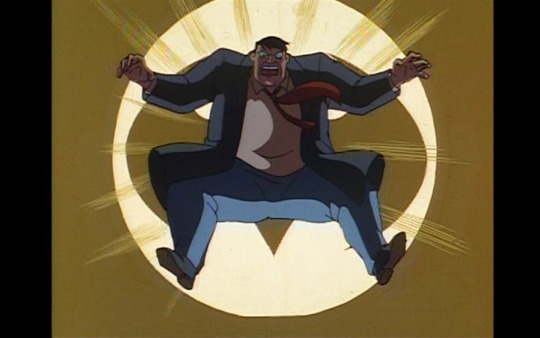
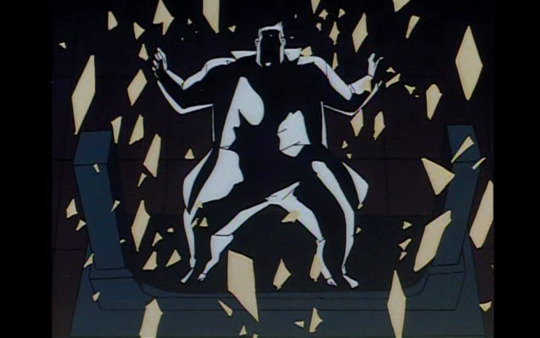
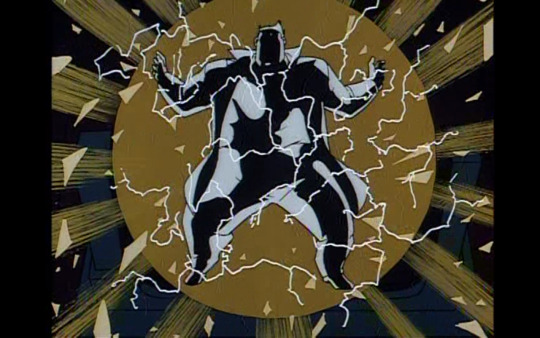
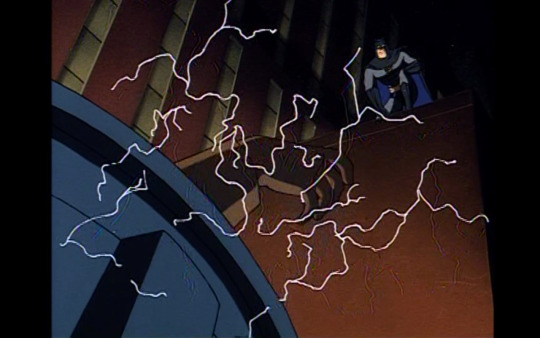
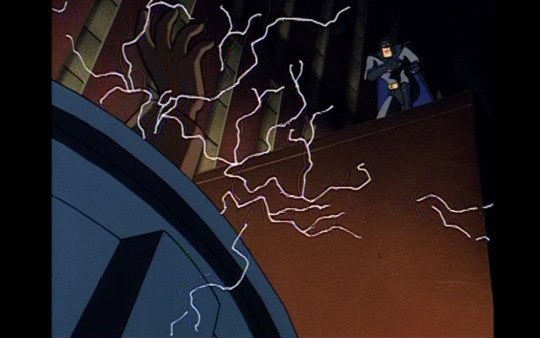
Bullock’s twitching hand was super gross. Anyone else agree that this is Sunrise’s best work on the show?
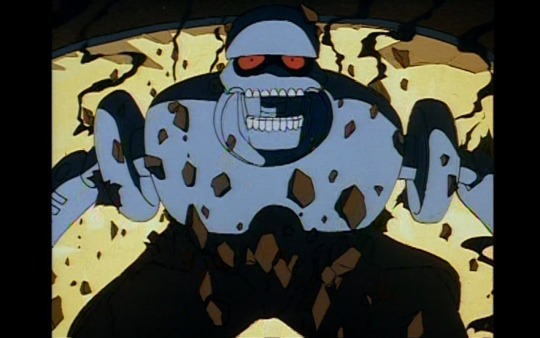

This robot almost looks zombie-like, which is fitting considering Bullock’s apparent demise.
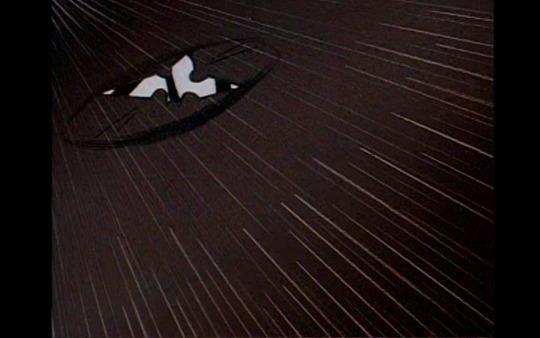
What happened to the batarangs, Batman?

Even when dead, those red eyes stare in such a malicious way.
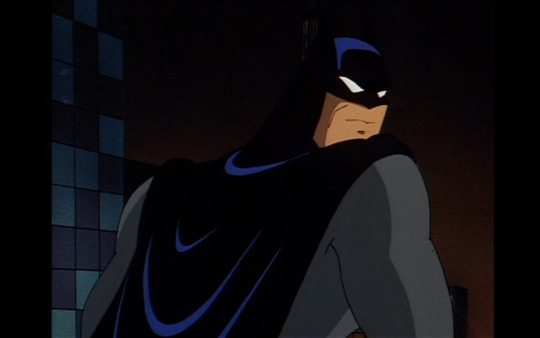
“Please let go of my cape.”
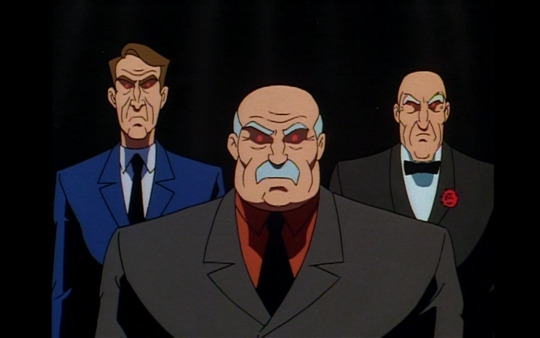
Is there any reason that these guy need to have light-up eyes like this? No! HARDAC clearly installed them just for the “Holy shit, what the hell is going on” factor.

Yes, HARDAC, humans are so imperfect. Meanwhile one of your friends lets Bruce slip away like this.
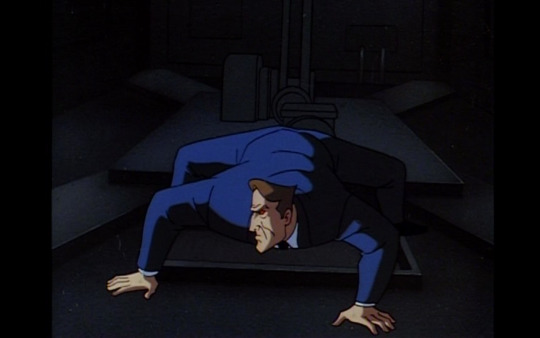


KILL IT. KILL IT. KILL IT.


THANK YOU.
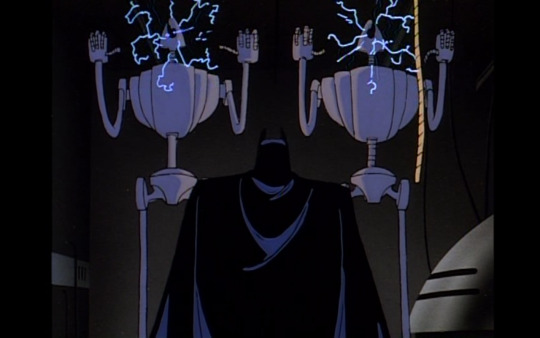
These trashcan robots very much look like the robots from Castle in the Sky.
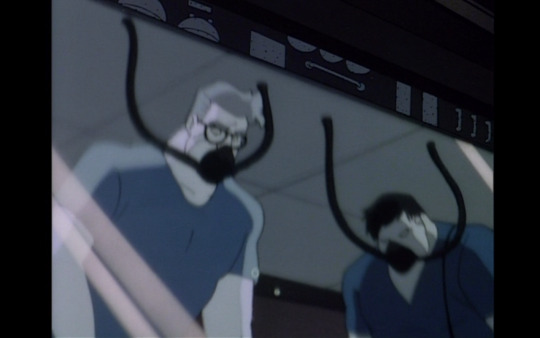
Seeing them in this kind of danger is quite disturbing. As is the fact that a computer is keeping humans contained like this.
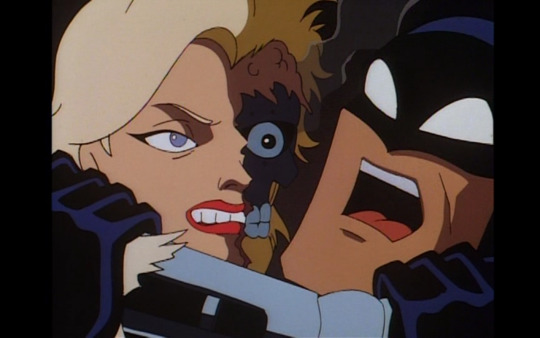
Up until now, we’ve only seen Randa as a drop-dead gorgeous woman. We saw the twist coming, yet it’s still quite the surprise!

A really stupid moment in an otherwise amazing half hour. A makeup mirror deflecting a laser like that felt really implausible (yes, in the face of everything else), and it also seemed like a lame way to remind us that Barbara is, in fact, a woman.
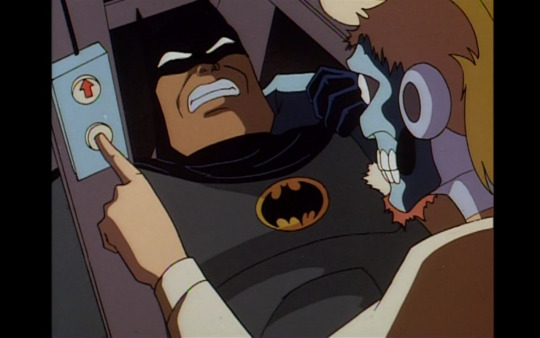
Batman panics as his head is about to be crushed by an elevator. Batman breaks a few times during Heart of Steel. He’s sure to experience some nightmares about computers.
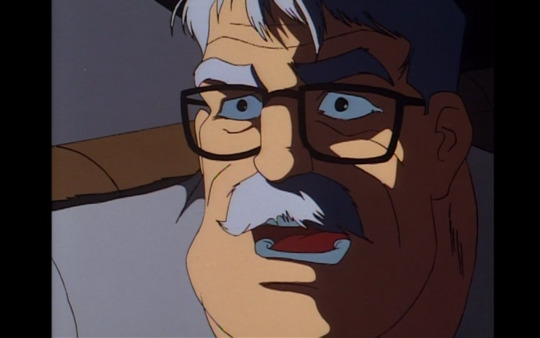
Bob Hastings has a tremendously good moment as he calls out the name of Jim’s daughter, thinking she’s dead.
Char’s grade: A Next time: If You’re So Smart, Why Aren’t You Rich?
Full episode list here!
#dcau#dc animated universe#heart of steel#part 2#heart of steel part 2#hardac#batman#batman tas#batman the animated series#btas#barbara gordon
2 notes
·
View notes